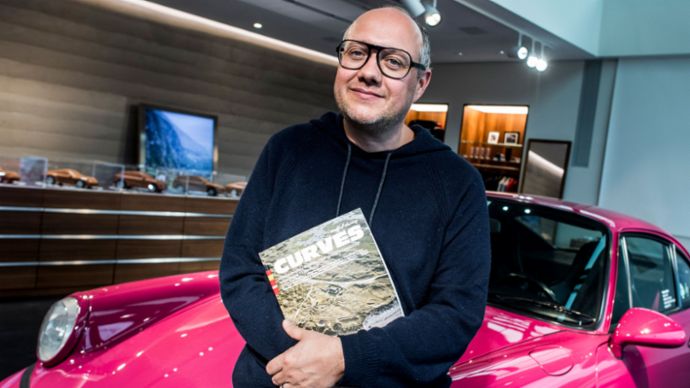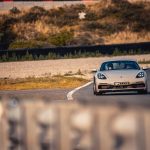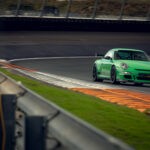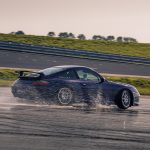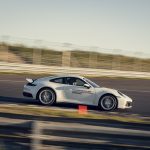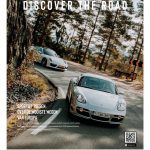“There’s something special about Porsche cars. They have the perfect interface and they always get a thumbs up from other people, no matter where I am in the world. The Porsche community is unique, and I think it’s because while the cars are exceptional, they are also approachable,” explains Bogner.

“We did the whole of the west coast of the United States in a very rare and old 906 racer but it never broke down. I can drive a Porsche race car for 5,000 kilometres and at the end, I’ll wash it and that’s all it needs. People think I’m mad taking these race cars on the road, but they’re perfect for it.”
With an “incredible” recent trip to Thailand fresh in his mind, and a healthy appetite for pre-dawn runs from his home in Munich to Italy’s Stelvio Pass in his 964 RS, he is eager to get back out on the road as soon as it is safe and permitted. Fortunately for Bogner, “the planning process is one of the best things about a road trip. Done properly it is huge fun” – and so he busily prepares for his next travels while at home.

With his work having already inspired a dedicated online and print following, here he shares his tips for creating the ultimate post-lockdown trip.
How to research the perfect road trip
“The most important thing is to take your time. If you were planning a month-long holiday, you’d take a long time getting it all just right. It’s the same with a road trip: preparation is key. This stage takes up about two thirds of my time and is my favourite aspect. I feel like an adventurer when I start to make new plans and the anticipation starts to build. It’s the coolest part.
I am old-school and I love to study paper maps and guide books. Get to grips with reading a map and you’ll get a better sense of place and perspective. Look for the green roads, as these are the scenic ones, and pay attention to the contour lines to get an idea of the topography. When you really study a physical map, the brain starts to absorb the information and when you come to drive a route, you’ll know much better where you are.
Digital tools have their place too. Once I’ve studied my maps and books, I’ll go online to add more information. I use software like Google Maps to adjust the route if I need to and to check journey times. It’s easy, but I don’t enjoy this part as much.”
Where to start
“I suggest picking somewhere relatively nearby for your first road trip – the Alps is always a good place to start for me because I live in Munich. Get in touch with locally-based friends, or use forums, Instagram and Facebook to learn about where you’re going and ask people for advice. Some tourist boards are excellent sources of information and inspiration.
My one timing rule is to avoid school holidays. I never go anywhere in July and August. Don’t be afraid to ask the locals the best time of year to visit their area, as no one will know the answer better than them. I was once planning a trip to Scotland and thought the summer would be the perfect time to go but a friend advised me to wait until October. I had the most amazing two weeks of sunshine with no rain. In Scotland!
Local contacts can also suggest their favourite museums (I have discovered some amazing private air museums in America this way) and restaurants. I am a real foodie so I enjoy researching amazing places to eat.
Think about the car you are going in. I am lucky to have driven some amazing cars over some of the world’s best roads. If you own a Porsche, you’ll find most of them will cover any sort of journey. I’ve found a 718 Cayman GT4 is perfect in the mountains as it’s narrow enough for the narrow roads, but also so well balanced for the hairpins.”
Get ready to roll
“Once you’ve worked out where you’re going, consider who you want to have with you. My best friend joins me on every trip but sometimes we travel in convoy with other cars. Eight cars is the maximum for me: any more than that and someone will always get lost or won’t make it through a set of traffic lights in time. With too many people involved it becomes hard work keeping everyone together.

Making sure the car is prepared is vital, especially if it’s an old one. I’ve been on trips with serious racing cars that you can also drive on the road and I always make sure I’ve had a look over them before I leave. Check the brakes, the lights, the liquids … basically, check everything. I always carry spare oil, some basic tools and, if I’m in an older model, I tend to take some electrical spare parts as the bare minimum. Things like a spare battery, rotor arm for the distributor, spark plugs, starter set. I also always pack some tyre foam as that has rescued me a lot.
Think about what to pack in your bag. It depends on the country and time of year but I always take a few very lightweight coats to keep off the rain and wind. A water bottle is essential, as is a multi-tool like a Swiss Army knife, and I’ll normally take a pair of trail running shoes as they’re light, comfortable and I can get out of the car to hike a short way for a photo.”
Keep things running smoothly on the road
“The first time I went to Iceland I had planned everything so beautifully but then the weather was changing every five minutes and I couldn’t do what I wanted to do. I was disappointed and frustrated, but the locals looked at where I was headed and simply told me to go the other way around. Of course they knew best and it worked. Always be flexible and willing to change your plans.
Preparation on the trip is as important as beforehand. I have a professional-grade weather app on my phone, which I check regularly. While I have a no-eating rule in my cars I always pack some mess-free energy bars to keep my sugar levels up if I’m on a longer journey. I’ll sometimes drive for eight hours a day and cover maybe 350 kilometres, and my photography is on top of that, so while I love finding good restaurants, having some snacks handy is important.
Have a rough idea of how far you want to drive each day but make sure you give yourself time to enjoy the trip, rather than running a tight schedule and insisting on being in a certain place by a precise time. Savour the scenery and enjoy the driving. If you take your time and you’re open to conversations when you fill up with fuel you’ll meet interesting people along the way.
If you are photographing your trip, as I do for Curves, it’s a good idea to know in advance where the best shots are. Research your “Instagram moments” when you first start planning but when you’re on the trip, make time to drive the best sections of your route a couple of times as each time it will look and feel different.
I could drive the Stelvio Pass every day and it would never be the same. Mornings and evenings are my favourite times to photograph scenery because the light isn’t as harsh. I also like pre and post peak season, when nature is often at its most dramatic.”
How to savour the moment
“Just as I’d recommend taking your time, so you should try to minimise the distractions. Switch off your phone and don’t constantly post where you are on social media. Part of the reason I don’t like camera phones is that I like to go offline when I’m shooting. When you get to your hotel in the evening, then you can switch back on and collate all your pictures. It’s much more fun and you’ll get to re-live the day again.
I switch off the in-car navigation when I’m on a road trip. If you can read a map you’ll have a good idea of where you need to be going. If you’re in the Alps, on a long winding pass, it’s not as if you are looking for an exit anyway – so you might as well savour the moment without devices talking to you. Sometimes I switch my music off and enjoy the silence. Travelling is all about engaging your senses and reverting to analogue ways helps to trigger much more feeling.

Returning home from an amazing trip can be a come-down so take some time out to look back through your photos and re-live all the amazing things you’ve experienced. If you turned your phone off during the journey and weren’t constantly updating your social media, you’ll remember different things when you’re looking back and it’ll make you more enthusiastic about planning the next adventure.
I’m always thinking of my next trip – they generally take me six to 12 months to plan so if you have spare time at the moment put it to use. Think about where you’ve always dreamt of going and, if it’s possible, make it happen. I love to see where people are planning to go and how they have captured where they have been.”
Source : Porsche Newsroom

